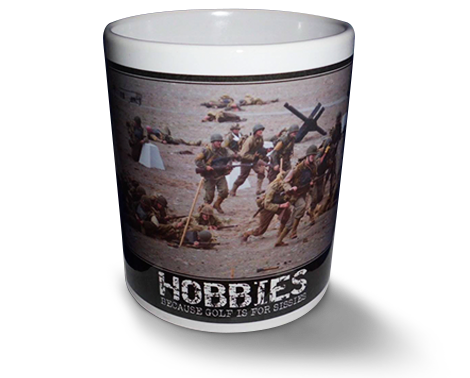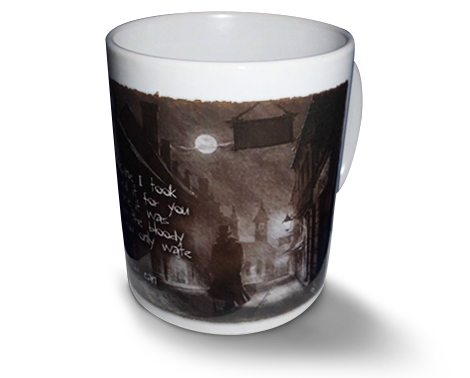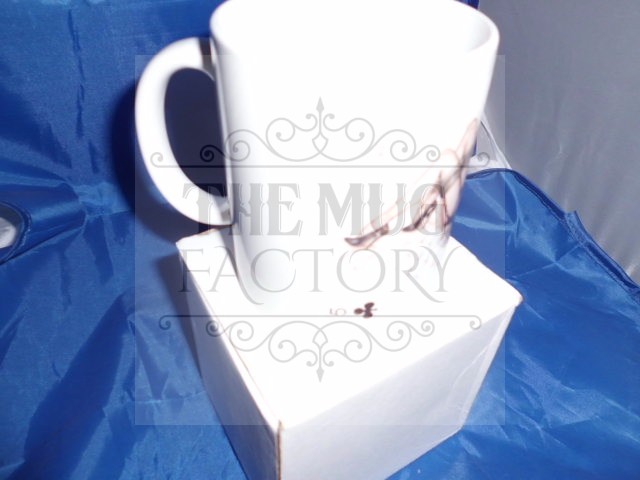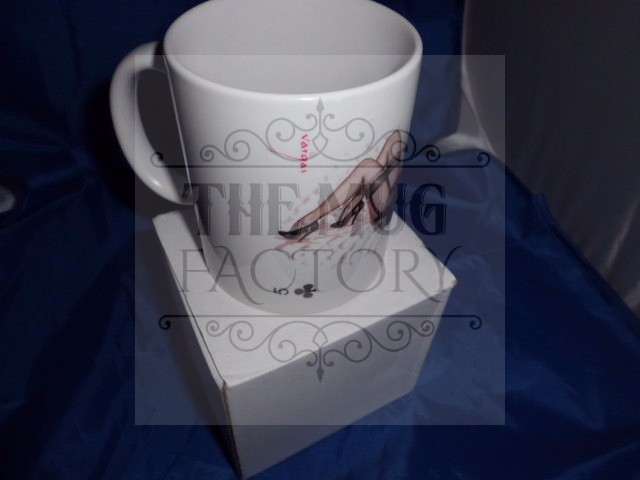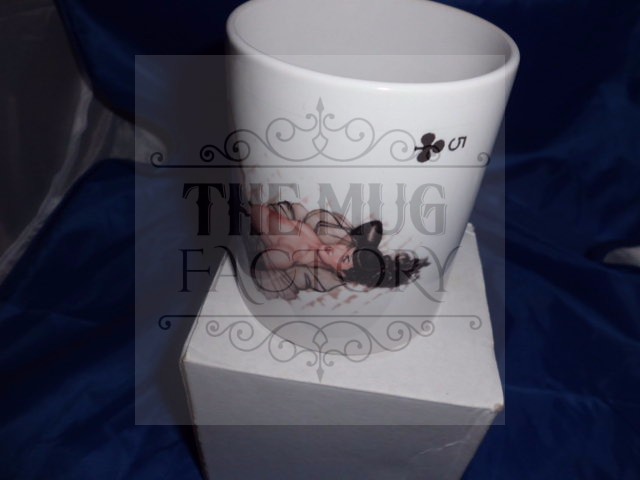Bettie Page risque mug
11oz Vintage Bettie Page mug
Date of Birth
22 April 1923, Nashville, Tennessee, USA
Date of Death
11 December 2008, Los Angeles, California, USA (heart attack)
Birth Name
Betty Mae Page
Nicknames
The Girl with the Perfect Figure
The Notorious Bettie Page
The Queen of Curves
The Dark Angel
Height
5' 5½" (1.66 m)
Bettie Page's life was filled with cult myth, mystery and sadness. Her image captured the imagination of a generation with her free spirit and unabashed sensuality, during an era of strong sexual repression. She was the quintessential pin-up, tacked up on walls in military barracks and garages; five decades later, some feminists still hail her as a pioneer of women's liberation. It has been estimated that over 20,000 photographs of Bettie were taken, and new generations of fans still buy copies by the thousands. Born in Nashville, Tennessee to a part-Cherokee mother, she grew up in a family so poor "we were lucky to get an orange in our Christmas stockings." The family included three boys and three girls, and Page later said her father molested all of the girls. He eventually stole a police car for a cross-country trip, was caught and sent to prison, and for a time Bettie lived in an orphanage. Her parents divorced when she was 10 years old.In her teens, Bettie acted in high school plays and was a straight-A student. She graduated from the Peabody College for Teachers in Nashville on a Daughters of the American Revolution scholarship in 1944, and went on to study drama in New York City. Her notorious career began one day in October 1950, while on a break from her job as a secretary in a New York office. On a walk along the beach at Coney Island, an amateur photographer admired the 27-year-old's curvaceous body and asked her to pose. Nudity didn't bother her, she said, likening it to Adam and Eve in the Garden of Eden. Her modeling career took off, and she was the centerfold in the January 1955 issue of then-fledgling Playboy magazine.In 1951, Bettie fell under the influence of Irving Klaw, a photographer. He cut her hair into the dark bangs that became her trademark, and posed her in spiked heels and little else. She also appeared as a performer in over 50 burlesque films. Her photos and films were publicly denounced by civic and religious leaders as "perversion", and Klaw was later arrested for "conspiracy to distribute obscene material" though the United States mail. Bettie was called to testify in a private session. Senator Estes Kefauver of Tennessee, her home state, even launched a congressional investigation against her. Believing that her days as a pin-up were over, Bettie retreated from public view, later saying she was hounded by federal agents. Her early marriage to her high school sweetheart had ended in divorce; she moved to Florida in 1957 and married a much younger man, but that marriage also failed, as did a third, and she suffered a nervous breakdown.In 1959, she was lying on a sea wall in Key West when she saw a church with a white neon cross on top. She walked inside and became a born-again Christian. After attending Bible school, she wanted to serve as a missionary but was turned down. Instead, she worked full-time for evangelist Billy Graham's ministry. However, a move to Southern California in 1979 brought her more troubles. She was arrested after an altercation with her landlady. Doctors diagnosed her as suffering from acute schizophrenia, and she spent 20 months in a state mental hospital in San Bernardino, and she was subsequently placed under state supervision for eight years.Her mysterious disappearance from the public eye only fueled the public's fascination. In fact, for two decades no one was sure where she was or even if she was still alive. She resurfaced in the 1990s after being tracked down for a documentary. She occasionally granted interviews and sold autographs, but refused to allow her picture to be taken in her old age. In a 1993 telephone interview, she told a reporter that she was "penniless and infamous." She later hired a law firm to help her recoup some of the profits being made with her likeness. She spent her final years living in Los Angeles with her brother.
In 1949, Page moved to New York City, where she hoped to find work as an actress. In the meantime, she supported herself by working as a secretary overlooking Rockefeller Center. In 1950, while walking alone along the Coney Island shore, Bettie met NYPD Officer Jerry Tibbs, who was an avid photographer, and he gave Bettie his card. He suggested she'd make a good pin-up model, and in exchange for allowing him to photograph her, he'd help make up her first pin-up portfolio, free of charge. It was Officer Tibbs who suggested to Bettie that she style her hair with bangs in front, to keep light from reflecting off her high forehead when being photographed. Bangs soon became an integral part of her distinctive look.
In late-1940s America, "camera clubs" were formed to circumvent laws restricting the production of nude photos. These camera clubs existed ostensibly to promote artistic photography, but in reality, many were merely fronts for the making of pornography. Page entered the field of "glamour photography" as a popular camera club model, working initially with photographer Cass Carr. Her lack of inhibition in posing made her a hit, and her name and image became quickly known in the erotic photography industry. In 1951, Bettie's image appeared in men's magazines such as Wink, Titter, Eyefull and Beauty Parade.
From 1952 through 1957, she posed for photographer Irving Klaw for mail-order photographs with pin-up and BDSM themes, making her the first famous bondage model. Klaw also used Page in dozens of short, black-and-white 8mm and 16mm "specialty" films, which catered to specific requests from his clientele. These silent 'one-reel' featurettes showed women clad in lingerie and high heels, acting out fetishistic scenarios of abduction, domination, and slave-training; bondage, spanking, and elaborate leather costumes and restraints were included periodically. Page alternated between playing a stern dominatrix, and a helpless victim bound hand and foot.
Klaw also produced a line of still photos taken during these sessions. Some have become iconic images, such as his highest-selling photo of Page—shown gagged and bound in a web of ropes, from the film Leopard Bikini Bound. Although these "underground" features had the same crude style and clandestine distribution as the pornographic "stag" films of the time, Klaw's all-female films never featured any nudity or explicit sexual content. Commenting on the bondage photos and the reputation they afforded her, Page said retrospectively:
They keep referring to me in the magazines and newspapers and everywhere else as the "Queen of Bondage." The only bondage posing I ever did was for Irving Klaw and his sister Paula. Usually every other Saturday he had a session for four or five hours with four or five models and a couple of extra photographers, and in order to get paid you had to do an hour of bondage. And that was the only reason I did it. I never had any inkling along that line. I don’t really disapprove of it; I think you can do your own thing as long as you’re not hurting anybody else — that’s been my philosophy ever since I was a little girl. I never looked down my nose at it. In fact, we used to laugh at some of the requests that came through the mail, even from judges and lawyers and doctors and people in high positions. Even back in the ’50s they went in for the whips and the ties and everything else.
In 1953, Page took acting classes at the Herbert Berghof Studio, which led to several roles on stage and television. She appeared on The United States Steel Hour and The Jackie Gleason Show. Her Off-Broadway productions included Time is a Thief and Sunday Costs Five Pesos. Page acted and danced in the feature-length burlesque revue film Striporama by Jerald Intrator in which she was given a brief speaking role. She then appeared in two more burlesque films by Irving Klaw (Teaserama and Varietease). These featured exotic dance routines and vignettes by Page and well-known striptease artists Lili St. Cyr and Tempest Storm. All three films were mildly risque, but none showed any nudity or overtly sexual content.
In 1954, during one of her annual vacations to Miami, Florida, Page met photographers Jan Caldwell, H. W. Hannau and Bunny Yeager. At that time, Page was the top pin-up model in New York. Yeager, a former model and aspiring photographer, signed Page for a photo session at the now-closed wildlife park Africa USA in Boca Raton, Florida. The Jungle Bettie photographs from this shoot are among her most celebrated. They include nude shots with a pair of cheetahs named Mojah and Mbili. The leopard skin patterned Jungle Girl outfit she wore was made, along with much of her lingerie, by Page herself. A large collection of the Yeager photos, and Klaw's, were published in the book Bettie Page Confidential (St. Martin's Press, 1994).
After Yeager sent shots of Page to Playboy founder Hugh Hefner, he selected one to use as the Playmate of the Month centerfold in the January 1955 issue of the two-year-old magazine. The famous photo shows Page, wearing only a Santa hat, kneeling before a Christmas tree holding an ornament and playfully winking at the camera. In 1955, Page won the title "Miss Pinup Girl of the World". She also became known as "The Queen of Curves" and "The Dark Angel". While pin-up and glamour models frequently have careers measured in months, Page was in demand for several years, continuing to model until 1957.
Although she frequently posed nude, she never appeared in scenes with explicit sexual content. In 1957, Page gave "expert guidance" to the FBI regarding the production of "flagellation and bondage pictures" in Harlem.
1958–92: Retirement; departure from spotlight
The reasons reported for Page's departure from modeling vary. Some reports mention the Kefauver Hearings of the United States Senate Special Committee to Investigate Crime in Interstate Commerce (after a young man apparently died during a session of bondage which was rumored to be inspired by bondage images featuring Page). However, the most likely reason for Page ending her modeling career and severing all contact with her prior life was her conversion to born-again Christianity while living in Key West, Florida, in 1959.
Photographer Sam Menning was the last person to photograph a pin-up of Page before her retirement.
On New Year's Eve 1958, during one of her regular visits to Key West, Florida, Page attended a service at what is now the Key West Temple Baptist Church. She found herself drawn to the multiracial environment and started to attend on a regular basis. She would in time attend three bible colleges, including the Bible Institute of Los Angeles, Multnomah University in Portland, Oregon and, briefly, a Christian retreat known as "Bibletown", part of the Boca Raton Community Church, Boca Raton, Florida.
She dated industrial designer Richard Arbib in the 1950s, and then married Armond Walterson in 1958; they divorced in 1963.
During the 1960s, she attempted to become a Christian missionary in Africa, but was rejected for having had a divorce. Over the next few years, she worked for various Christian organisations before settling in Nashville in 1963, and re-enrolled at Peabody College to pursue a master's degree in education, but eventually dropped out. She worked full-time for Rev. Billy Graham.
She briefly remarried Billy Neal, her first husband, who helped her to gain entry into missionary work; however, the two divorced again shortly thereafter. She returned to Florida in 1967, and married again, to Harry Lear, but this marriage ended in divorce in 1972.
She moved to Southern California in 1979. There she had a nervous breakdown and had an altercation with her landlady. The doctors who examined her diagnosed her with acute schizophrenia, and she spent 20 months in Patton State Hospital in San Bernardino, California. After a fight with another landlord, she was arrested for assault, but was found not guilty by reason of insanity and placed under state supervision for eight years. She was released in 1992.
Revival of public interest[edit]
In the 1970s, artists Eric Stanton, Robert Blue and Olivia De Berardinis were among the first to start painting Bettie images. In 1979, artist Robert Blue had a show titled Steps Into Space, at a gallery on Melrose Place in Los Angeles, where he showed his collection of Bettie Page paintings. At that time in New York, artist Olivia De Berardinis had begun painting Bettie for Italian jean manufacturer Fiorucci. Olivia has continued to paint Bettie, and compiled a collection of this artwork in a book titled Bettie Page by Olivia (2006), with a foreword by Hugh Hefner. To mark the millennium on an international scale, renowned Japanese artist Hajime Sorayama created original art of Bettie Page, placing her on the pedestal of highly accomplished, beautiful women.
In 1976, Eros Publishing Co. published A Nostalgic Look at Bettie Page, a mixture of photos from the 1950s. Between 1978 and 1980, Belier Press published four volumes of Betty Page: Private Peeks, reprinting pictures from the private-camera-club sessions, which reintroduced Page to a new but small cult following. In 1983, London Enterprises released In Praise of Bettie Page — A Nostalgic Collector's Item, reprinting camera club photos and an old cat fight photo shoot.
A larger cult following was built around Page during the 1980s, of which she was unaware. This renewed attention was focused on her pinup and lingerie modeling rather than those depicting sexual fetishes or bondage, and she gained a certain public redemption and popular status as an icon of erotica from a bygone era. This attention also raised the question among her new fans of what happened to her after the 1950s. The 1990s edition of the popular Book of Lists included Page in a list of once-famous celebrities who had seemingly vanished from the public eye.
In the early 1980s, comic book artist Dave Stevens based the female love interest of his hero Cliff Secord (alias "The Rocketeer") on Page.
By the mid 1980s Olivia De Berardinis noted that women began to frequent her gallery openings sporting Bettie bangs, fetish clothing, and tattoos of Page. Olivia said, “Black bangs, seamed stockings and snub nosed 6″ stilettos. These are Bettie Page signatures, anyone who dons them wears her crown. Although the fantasy world of fetish/bondage existed in some form since the beginning time, Bettie is the iconic figurehead of it all. No star of this genre existed before her. Monroe had predecessors, Bettie did not.”
In 1987, Greg Theakston started a fanzine called The Betty Pages and recounted tales of her life, particularly the camera club days. For the next seven years, the magazine sparked a worldwide interest in Page. Women dyed their hair and cut it into bangs in an attempt to emulate the "Dark Angel". The media caught wind of the phenomenon and wrote numerous articles about her, more often than not with Theakston's help. Since almost all of her photos were in the public domain, opportunists launched related products and cashed in on the burgeoning craze.
In a 1993 telephone interview with Lifestyles of the Rich and Famous, Page told host Robin Leach that she had been unaware of the resurgence of her popularity, stating that she was "penniless and infamous". Entertainment Tonight produced a segment on her. Page, who was living in a group home in Los Angeles, was astounded when she saw the E.T. piece, having had no idea that she had suddenly become famous again. Greg Theakston contacted her and extensively interviewed her for The Betty Page Annuals V.2.
Shortly afterward, Page signed with Chicago-based agent James Swanson. Three years later, nearly penniless and failing to receive any royalties, Page fired Swanson and signed with Curtis Management Group, a company which also represented the James Dean and Marilyn Monroe estates. She then began collecting payments which ensured her financial security.
After Jim Silke made a large format comic featuring Page's likeness, Dark Horse Comics published a comic based on her fictional adventures in the 1990s. Eros Comics published several Bettie Page titles, the most popular being the tongue-in-cheek Tor Love Bettie which suggested a romance between Page and wrestler-turned-Ed Wood film actor, Tor Johnson.
The question of what Page did in the obscure years after modeling was answered in part with the publication of an official biography in 1996, Bettie Page: The Life of a Pin-up Legend. That year, Page granted an exclusive one-on-one TV interview to entertainment reporter Tim Estiloz for a short-lived NBC morning magazine program Real Life, to help publicise the book. The interview featured her reminiscing about her career and relating anecdotes about her personal life, as well as photos from her personal collection. At Page's request, her face was not shown. The interview was broadcast only once.
Another biography, The Real Bettie Page: The Truth about the Queen of Pinups (1997) was written by Richard Foster. Foster's book immediately provoked attacks from Page's fans, including Hugh Hefner and Harlan Ellison, as well as a statement from Page that it was "full of lies", because they were not pleased that the book revealed a Los Angeles County Sheriff's police report that stated Page suffered from paranoid schizophrenia and, at age 56, had stabbed her elderly landlords on the afternoon of April 19, 1979 in an unprovoked attack, during a fit of insanity. However, Steve Brewster, founder of The Bettie Scouts of America fan club, has stated that it is not as unsympathetic as some believe it to be. Brewster adds that he also read the chapter about her business dealings with Swanson, and stated that Page was pleased with that part of her story.
In 1997, E! True Hollywood Story aired a feature on Page titled, Bettie Page: From Pinup to Sex Queen.
In a late-1990s interview, Page stated she would not allow any current pictures of her to be shown because of concerns about her weight. However, in 1997, Page changed her mind and agreed to a rare television interview for the aforementioned E! True Hollywood Story/Page special on the condition that the location of the interview and her face not be revealed (she was shown with her face and dress electronically blacked out). Page allowed a publicity picture to be taken of her for the August 2003 edition of Playboy. In 2006, the Los Angeles Times ran an article headlined A Golden Age for a Pinup, covering an autographing session at her current publicity company, CMG Worldwide. Once again, Page declined to be photographed, saying she would rather be remembered as she was.
In a 1998 interview with Playboy, she commented on her career:
I never thought it was shameful. I felt normal. It's just that it was much better than pounding a typewriter eight hours a day, which gets monotonous.
Within the last few years, she had hired a law firm to help her recoup some of the profits being made with her likeness. According to MTV: "Katy Perry's rocker bangs and throwback skimpy jumpers. Madonna's Sex book and fascination with bondage gear. Rihanna's obsession with all things leather, lace and second-skin binding. Uma Thurman in Pulp Fiction. The SuicideGirls Web site. The Pussycat Dolls. The entire career of Marilyn Manson's ex-wife Dita Von Teese." would not have been possible without Page.
In 2011, Page's estate made the Forbes annual list of top-earning dead celebrities, earning $6 million and tied with the estates of George Harrison and Andy Warhol, at 13th on the list. In 2014, Forbes estimated that Page's estate earned $10 million in 2013.
Bettie Page's grave
According to long-time friend and business agent Mark Roesler, Page was hospitalized in critical condition on December 6, 2008. Roesler was quoted by the Associated Press as saying Page had suffered a heart attack and by Los Angeles television station KNBC as claiming Page was suffering from pneumonia. Her family eventually agreed to discontinue life support, and she died at 18:41 PST on December 11, 2008.
She is buried at Westwood Village Memorial Park Cemetery. Her headstone lists her name as "Bettie Mae Page" and includes the legend "Queen of Pin-Ups".
In 2004, Cult Epics produced the biographical film Bettie Page: Dark Angel. This low-budget straight-to-disc biopic centers on the 1953–1957 Irving Klaw period, faithfully recreating six lost fetish films she did for Klaw. Model Paige Richards plays the title role.
The Notorious Bettie Page (2005) follows her life from the mid-1930s through the late-1950s. It stars actress Gretchen Mol as the adult Page. Bonus footage added to the DVD release includes rare color film from the 1950s of Page playfully undressing and striking various nude poses for the camera.
In 2012, Bettie Page Reveals All was filmed and premiered, then released nationwide the following year. It was an authorised biographical documentary by Academy Award-nominated director Mark Mori. The documentary included narration from Bettie Page herself, culled from over 6 hours of interviews prior to her 2008 death. The film also included commentary from individuals such as Dita Von Teese, Hugh M. Hefner, Rebecca Romijn, Tempest Storm, Bunny Yeager, Paula Klaw, Mamie Van Doren and Naomi Campbell.
In 2006, Page and Halo Custom Guitars, in Cupertino, California, collaborated to produce a limited edition of custom guitars bearing her image on the front. The line was released at the 2007 Winter NAMM Show in southern California. The total run of 100 guitars was handmade and designed by luthier Waylon Ford, with art designed by Pamelina H. It is the only collector guitar series authorised by Bettie Page.
The mugs we use are top quality bright white, Orca coated, and are Dishwasher and Microwave safe, the high quality images are bonded into the surface of the mug, and do not fade or peel off like transfers
GREAT FOR GIFTS, BIRTHDAYS, OR JUST TO ADD TO YOUR MEMORABILIA COLLECTION.
The artwork is created in our offices/workshop, and we are available for custom work. These designs are individually made, not mass produced.
Please note that I take great care in packaging the mugs they are sent in a polystyrene mug box designed to specifically for posting mugs hence the postage costs

